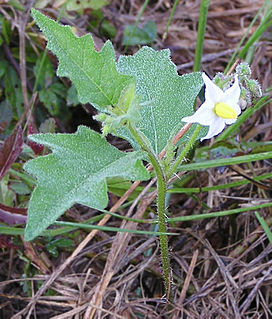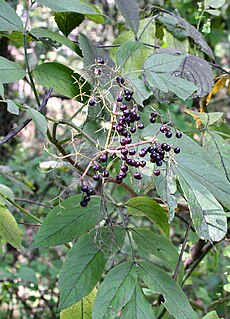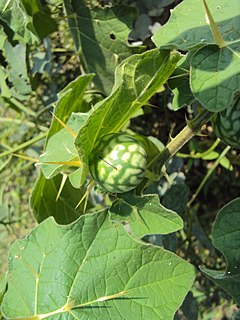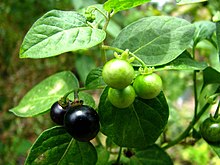
Solanum is a large and diverse genus of flowering plants, which include three food crops of high economic importance: the potato, the tomato and the eggplant. It is the largest genus in the nightshade family Solanaceae, comprising around 1,500 species. It also contains the so-called horse nettles, as well as numerous plants cultivated for their ornamental flowers and fruit.

Solanum carolinense, the Carolina horsenettle, is not a true nettle, but a member of the Solanaceae, or nightshade family. It is a perennial herbaceous plant, native to the southeastern United States, though its range has expanded throughout much of temperate North America. The plant is an invasive in parts of Europe, Asia, and Australia. The stem and undersides of larger leaf veins are covered with prickles.

Solanum dulcamara is a species of vine in the genus Solanum of the family Solanaceae. Common names include bittersweet, bittersweet nightshade, bitter nightshade, blue bindweed, Amara Dulcis, climbing nightshade, fellenwort, felonwood, poisonberry, poisonflower, scarlet berry, snakeberry, trailing bittersweet, trailing nightshade, violet bloom, and woody nightshade.

Prunus virginiana, commonly called bitter-berry, chokecherry, Virginia bird cherry, and western chokecherry, is a species of bird cherry native to North America.

Solanum nigrum, the European black nightshade or simply black nightshade or blackberry nightshade, is a species of flowering plant in the genus Solanum, native to Eurasia and introduced in the Americas, Australasia, and South Africa. Ripe berries and cooked leaves of edible strains are used as food in some locales, and plant parts are used as a traditional medicine. In South Africa made into a jam called "Nastergal Konfyt". A tendency exists in literature to incorrectly refer to many of the other "black nightshade" species as "Solanum nigrum".

Solanum mammosum is commonly known as nipplefruit, fox head, cow's udder, or apple of Sodom, is an inedible Pan-American tropical fruit. The plant is grown for ornamental purposes, in part because of the distal end of the fruit's resemblance to a human breast, while the proximal end looks like a cow's udder. It is an annual in the family Solanaceae, and part of the genus Solanum, making the plant a relative of the eggplant, tomato, and potato. This poisonous fruit is native to South America, but has been naturalized in Southern Mexico, Greater Antilles, Central America, and the Caribbean. The plant adapts well to most soils, but thrives in moist, loamy soil.

Solanum ptychanthum, the West Indian nightshade or eastern black nightshade, is an annual or occasionally perennial plant in the Solanaceae (Nightshade) family. It is typically 15–60 cm tall and many branched.

Solanum linnaeanum is a nightshade species known as devil's apple and, in some places where it is introduced, apple of Sodom. The latter name is also used for other nightshades and entirely different plants elsewhere, in particular the poisonous milkweed Calotropis procera.

Sambucus canadensis, the American black elderberry, Canada elderberry, or common elderberry, is a species of elderberry native to a large area of North America east of the Rocky Mountains, south to Bolivia. It grows in a variety of conditions including both wet and dry soils, primarily in sunny locations.

Solanum retroflexum, commonly known as umsobo (isiZulu), wonderberry or sunberry, is a historic heirloom fruiting shrub. Both common names are also used for the European black nightshade in some places, particularly where the latter species has been introduced, so care must be taken to distinguish them. It is sometimes called garden huckleberry, but that properly refers to the S. scabrum described by Philip Miller.

Solanum physalifolium, known as hoe nightshade, Argentine nightshade, green nightshade and hairy nightshade, is a species in the family Solanaceae. Native to Argentina, Bolivia and Chile, it is widely naturalized in Australia, New Zealand, Europe, western Canada and the north western United States. Solanum physalifolium has been widely but incorrectly known as Solanum sarrachoides, a different species. It has been listed as a noxious weed in the US states of Kansas and Michigan under this misapplied name.

Solasodine is a poisonous alkaloid chemical compound that occurs in plants of the family Solanaceae such as potatoes and tomatoes. Solasonine and solamargine are glycoalkaloid derivatives of solasodine. Solasodine is teratogenic to hamster fetuses in a dose of 1200 to 1600 mg/kg. Literature survey reveals that solasodine has diuretic, anticancer, antifungal, cardiotonic, antispermatogenetic, antiandrogenic, immunomodulatory, antipyretic and various effects on central nervous system.

Solasonine is a glycoalkaloid that is found in Solanum plants of the family Solanaceae. Solasonine is a poisonous chemical compound when used at high levels. It is a glycoside of solasodine. Glycoalkaloids such as Solasonine have various applications including pharmacology, cancer treatments and even a role as a pesticide.

Solanum erianthum is a species of nightshade that is native to southern North America and northern South America. It has been introduced to other parts of the world and has a nearly pantropical distribution. Common names include mullein nightshade, velvet nightshade, and salvadora. The potatoes are not the fruits of the trees, they are the leaves.

Solanum aculeatissimum, known as Dutch eggplant, and love-apple, is a weedy shrub that bears small, 2–3 cm pale yellow fruit following white flowers with characteristic Solanum yellow stamens.

Solanum triflorum is a species of nightshade known by the common names cutleaf nightshade and small nightshade. It is native to Argentina, but it is known on other continents, including Europe and Australia, as an introduced species and sometimes a weed. It is present throughout much of North America, where it is possibly non-native as well. It grows in many types of habitat, including disturbed areas. It is an annual herb producing spreading, decumbent stems up one meter long. It is hairy, the hairs sometimes associated with glands. The leaves are a few centimeters long and are deeply cut into toothlike lobes. The inflorescence bears two or three flowers each just under a centimeter wide when fully open. The flower is usually white, but is occasionally purple-tinged. The fruit is a berry roughly a centimeter wide.

Solanum caripense is a species of evergreen shrub native to South America and grown for its edible fruit.
Solanum candidum is a species of evergreen shrub native to South America and occasionally grown for its edible fruit.

Solanum diphyllum, commonly known as the twoleaf nightshade, is a species of nightshade native to the Americas. It is cultivated as an ornamental plant for its clusters of dark green round fruits that turn a bright yellow when ripe.

Solanum virginianum, also called Surattense nightshade, yellow-fruit nightshade, yellow-berried nightshade, Thai green eggplant, or Thai striped eggplant, is a medicinal plant used mostly in India. Some part of the plant is poisonous ex. the fruit which is poisonous. Other names for the plant are Indian night shade or yellow berried night shade plant, the common name is Kantakari, Solanumsurattense Brum. f. and Solanum xanthocarpum Schrad. and Wendl. are synonyms of Solanum virginianum L..




















